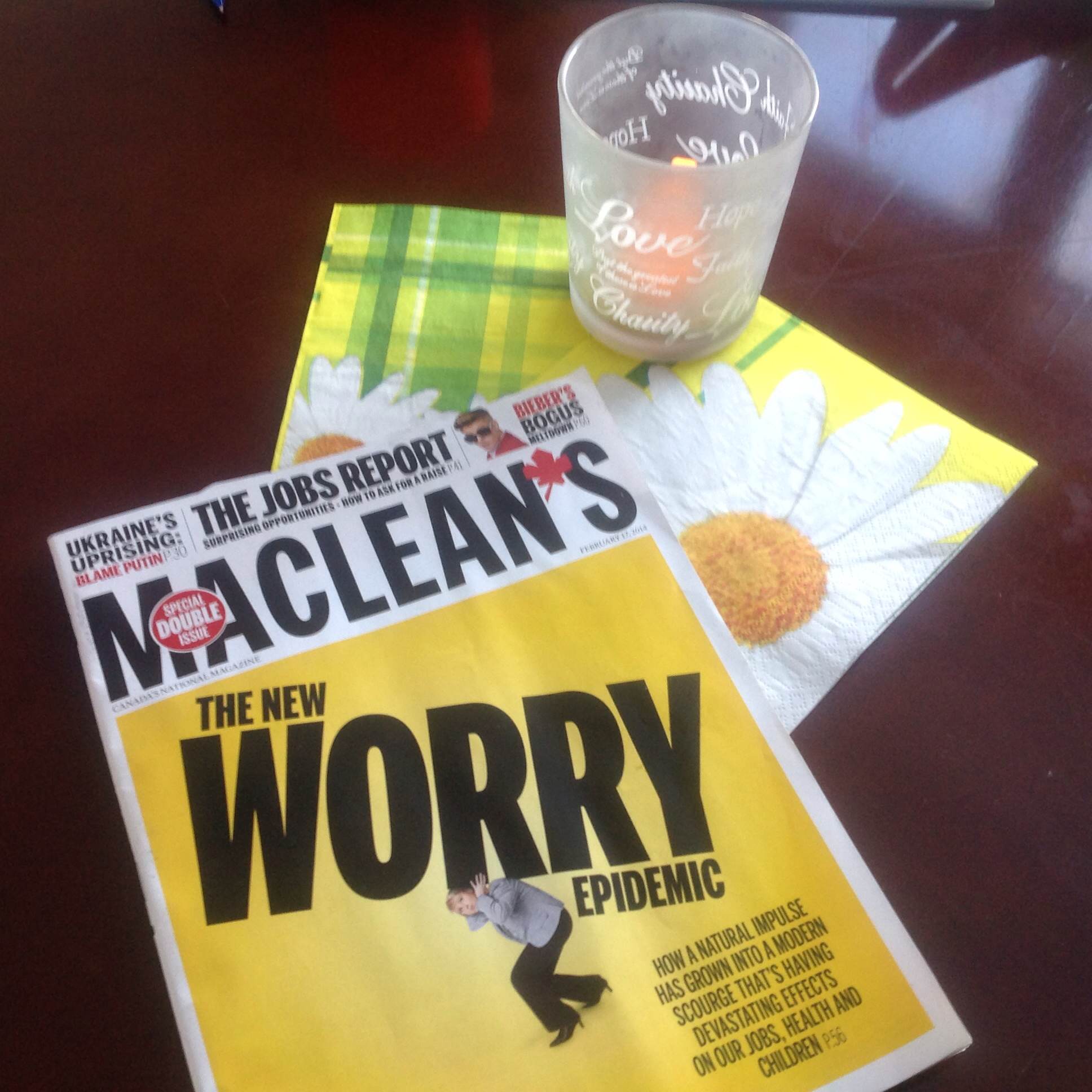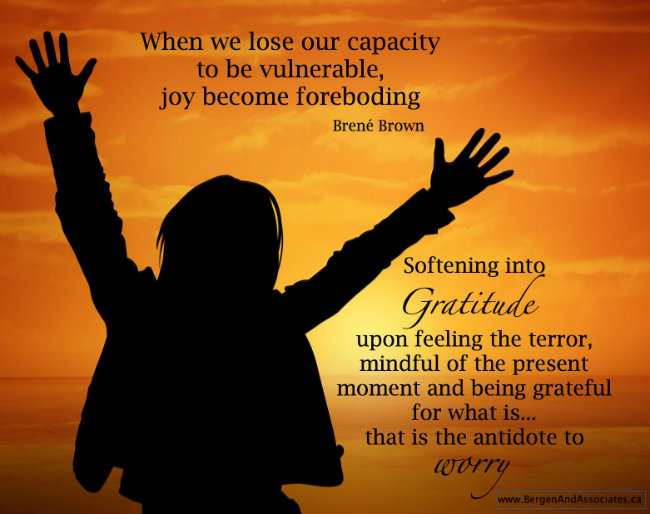The February 17th edition of Maclean’s magazine’s cover story was all about “The new worry epidemic”. In the article, worry is used interchangeably with anxiety, both of which are different than fear.
 Fear is the
Fear is the
“flight/fright/freeze” response that occurs when one is exposed to a threat of some kind…a danger. Fear is in the now.
Anxiety/worry is the same “flight/fright/freeze” response, but it is anticipatory. Nothing has happened yet.
Anxiety/worry happens when we don’t know what will happen, but we feel as if the threat/danger will happen. That’s an uncomfortable feeling, that space of emotional vulnerability…that feeling of “uncertainty, risk, and emotional exposure” (Brené Brown)
Worry, the Macleans article says, is “the No. 1 way to increase ratings or sell products”. The advertising industry is built on a foundation of worry: buy this hand soap because you would be horrified to know how many bacteria other soap leaves behind, or buy this car because we have more airbags and look what happens inside to passengers when a vehicle hits a brick wall. Buy this face cream to remove fine lines (which, by implication, are bad…very bad. A classic example of creating worry where none existed before)
The internet has given us tools to help our worry go viral. A simple cold can potentially be three or four very rare diseases (that no one heard of or would know to worry about without the internet) and food experts will contradict each other regularly about how much fish we should eat or what makes up a healthy diet for a child.
Perhaps the greatest sources of worry are those voices we all have inside of us that say, “You’re not good enough”, “You’re not worth it”. These voices tell us we are special or accomplished enough to be worthy of love and belonging…which, by now, if you’re a regular reader on this blog, you would know that this is what Brené Brown calls shame.
Some ways of handling shame actually create worry…working at the shame issue (albeit ineffectively) creates a worry issue…in at least three ways.
I see several reasons why worry can feel like a good idea to folks:
1. It’s a buffer from disappointment. Worry prevents a person from getting too excited and joyful…by dress rehearsing tragedy, we keep our joy in check. Joy can be dangerous to feel. Many would rather live in disappointment than become disappointed. Brené Brown calls this foreboding joy.
2. It helps reduce uncertainty. Uncertainly feels vulnerable. There’s something oddly comforting about making an uncertain situation more certain in a person’s life, even if it is by deciding certain tragedy. Wondering if you might make the team is likely actually harder than deciding you probably didn’t make the team.
3. It’s inevitable when we set impossible standards. When we have those outer voices (internet, advertising, and the critics in our lives) and the inner gremlins chirping at us, one of the ways of coping is the very heavy shield of “Perfectionism”. There is this magical thinking that if we meet a high enough standard, we will prove ourselves worthy of love and belonging. This isn’t healthy striving…this is pushing to attain an unreachable goal.
…and, no great news bulletin here…trying to reach an unattainable goal sets a person up for failure…and it’s no surprise that people worry about that failure. The Maclean’s article talks about a developing phenomena of “school refusal”, something seen in very good students as they become paralyzed by the worry/anxiety of school.
To explain further:
Worry, the anticipation of a threat, can forecast failure/threat/doom so much as so encourage withdrawal and disengagement.
Worry creates the threat response, without knowing bad things will happen…which in itself is stressful for the body. Years ago, I remember worrying a great deal about the possibility my children would die of Sudden Infant Death Syndrome…I lost sleep over it, and much worry went into something that never happened. (Please know it’s hasn’t all been roses and butterflies though–other terrible things happened that I didn’t anticipate and couldn’t worry about). The worry about SIDS took away from my ability to be rest while my children were sleeping, which ironically, impacted my ability to fully be the mother I wanted to be with them. I simply enjoyed my children less because of my worry…and that had me be a less present mother.
Worry sucks the joy out of life. Yes, bad things happen, certainly, but worrying by anticipating and planning for tragedy actually doesn’t prepare us for tragedy. It actually reduces our inner reserves of joy which can leave us less prepared to deal with the inevitable difficulties in our lives.

The Macleans article refers to the usefulness of worry, helping pilots and navy seals be more successful in their jobs. People who have the “worry gene” seem to do well in jobs that require detailed planning, and the foresight of numerous outcomes.
Seems to me that this “worry gene” actually turns into a “healthy striving” gene for these people…where people use the discomfort of what might happen into an internally motivated energy to do their best in a difficult and stressful situation. They can only do such high performance jobs if they aren’t swamped into a swamp of worried despair.
I believe that people adopt a lifestyle of worry in the belief it will help them ward off disaster, and give them more successful, happier lives. Worry doesn’t prevent thing from happening, but it does squander joy…which fills us up to give us what we need to be able to handle all that life offers us.
The antidote to foreboding joy, as Brené Brown says, is, to acknowledge the shudders of worry when they come--and to use them as cues for gratitude. To soften into gratitude is to recognize the preciousness of the present moment, and be grateful for what is.
To learn more about how I work with clients who have feel caught up in this worry epidemic, read Daring Greatly, or consider attending The Daring Way™ workshop.
*this was the topic of the week with Dahlia Kurtz on CJOB 680.






Write a Comment